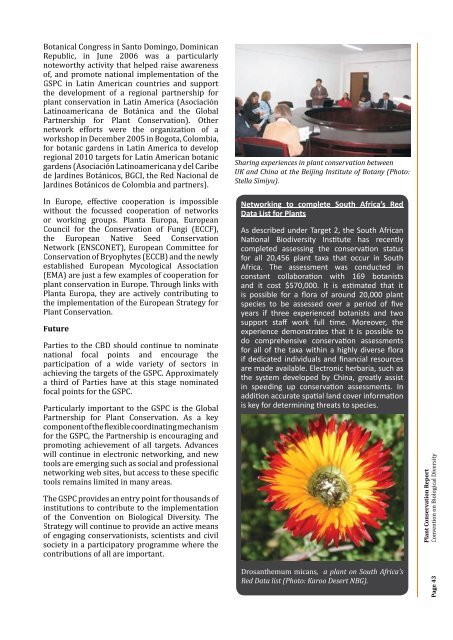from the global partnership for plant conservation
from the global partnership for plant conservation
from the global partnership for plant conservation
You also want an ePaper? Increase the reach of your titles
YUMPU automatically turns print PDFs into web optimized ePapers that Google loves.
Botanical Congress in Santo Domingo, DominicanRepublic, in June 2006 was a particularlynoteworthy activity that helped raise awarenessof, and promote national implementation of <strong>the</strong>GSPC in Latin American countries and support<strong>the</strong> development of a regional <strong>partnership</strong> <strong>for</strong><strong>plant</strong> <strong>conservation</strong> in Latin America (AsociaciónLatinoamericana de Botánica and <strong>the</strong> GlobalPartnership <strong>for</strong> Plant Conservation). O<strong>the</strong>rnetwork ef<strong>for</strong>ts were <strong>the</strong> organization of aworkshop in December 2005 in Bogota, Colombia,<strong>for</strong> botanic gardens in Latin America to developregional 2010 targets <strong>for</strong> Latin American botanicgardens (Asociación Latinoamericana y del Caribede Jardines Botánicos, BGCI, <strong>the</strong> Red Nacional deJardines Botánicos de Colombia and partners).Sharing experiences in <strong>plant</strong> <strong>conservation</strong> betweenUK and China at <strong>the</strong> Beijing Institute of Botany (Photo:Stella Simiyu).In Europe, effective cooperation is impossiblewithout <strong>the</strong> focussed cooperation of networksor working groups. Planta Europa, EuropeanCouncil <strong>for</strong> <strong>the</strong> Conservation of Fungi (ECCF),<strong>the</strong> European Native Seed ConservationNetwork (ENSCONET), European Committee <strong>for</strong>Conservation of Bryophytes (ECCB) and <strong>the</strong> newlyestablished European Mycological Association(EMA) are just a few examples of cooperation <strong>for</strong><strong>plant</strong> <strong>conservation</strong> in Europe. Through links withPlanta Europa, <strong>the</strong>y are actively contributing to<strong>the</strong> implementation of <strong>the</strong> European Strategy <strong>for</strong>Plant Conservation.FutureParties to <strong>the</strong> CBD should continue to nominatenational focal points and encourage <strong>the</strong>participation of a wide variety of sectors inachieving <strong>the</strong> targets of <strong>the</strong> GSPC. Approximatelya third of Parties have at this stage nominatedfocal points <strong>for</strong> <strong>the</strong> GSPC.Particularly important to <strong>the</strong> GSPC is <strong>the</strong> GlobalPartnership <strong>for</strong> Plant Conservation. As a keycomponent of <strong>the</strong> lexible coordinating mechanism<strong>for</strong> <strong>the</strong> GSPC, <strong>the</strong> Partnership is encouraging andpromoting achievement of all targets. Advanceswill continue in electronic networking, and newtools are emerging such as social and professionalnetworking web sites, but access to <strong>the</strong>se speciictools remains limited in many areas.The GSPC provides an entry point <strong>for</strong> thousands ofinstitutions to contribute to <strong>the</strong> implementationof <strong>the</strong> Convention on Biological Diversity. TheStrategy will continue to provide an active meansof engaging <strong>conservation</strong>ists, scientists and civilsociety in a participatory programme where <strong>the</strong>contributions of all are important.The Global Partnership <strong>for</strong> Plant Conservation -Networking to complete South Africa’s RedData List <strong>for</strong> PlantsAs described under Target 2, <strong>the</strong> South AfricanNational Biodiversity Institute has recentlycompleted assessing <strong>the</strong> <strong>conservation</strong> status<strong>for</strong> all 20,456 <strong>plant</strong> taxa that occur in SouthAfrica. The assessment was conducted inconstant collaboration with 169 botanistsand it cost $570,000. It is estimated that itis possible <strong>for</strong> a flora of around 20,000 <strong>plant</strong>species to be assessed over a period of fiveyears if three experienced botanists and twosupport staff work full time. Moreover, <strong>the</strong>experience demonstrates that it is possible todo comprehensive <strong>conservation</strong> assessments<strong>for</strong> all of <strong>the</strong> taxa within a highly diverse floraif dedicated individuals and financial resourcesare made available. Electronic herbaria, such as<strong>the</strong> system developed by China, greatly assistin speeding up <strong>conservation</strong> assessments. Inaddition accurate spatial land cover in<strong>for</strong>mationis key <strong>for</strong> determining threats to species.Drosan<strong>the</strong>mum micans, a <strong>plant</strong> on South Africa'sRed Data list (Photo: Karoo Desert NBG).Plant Conservation ReportPage 43 Convention on Biological Diversity
















